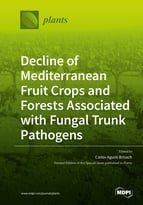Decline of Mediterranean Fruit Crops and Forests Associated with Fungal Trunk Pathogens
A special issue of Plants (ISSN 2223-7747). This special issue belongs to the section "Plant Protection and Biotic Interactions".
Deadline for manuscript submissions: closed (31 March 2021) | Viewed by 37829
Special Issue Editor
Interests: biocontrol; etiology; epidemiology; fungi; integrated pest management; Mediterranean fruit crops; phytopathology; plant–pathogen–environment interactions; fungal trunk and vascular diseases
Special Issues, Collections and Topics in MDPI journals
Special Issue Information
Dear Colleagues,
Tree decline has been a growing syndrome in agriculture and forest ecosystems in recent decades, causing major economic losses worldwide. This syndrome has been categorized as a complex disease due to the wide diversity of symptoms expression, as well as the multiple fungal species associated with the disease. Tree decline can express itself in a broad diversity of symptoms, including chlorotic and necrotic leaves, shoot blight, branch dieback, cankers in the tree trunk, crown rot, gummosis, internal wood discoloration, and/or reduction in root biomass and root necrosis. When the disease progresses, the tree shows general debilitation and eventually dies. Symptoms vary depending on the biology of the causal agent, the affected host, the environmental and agronomical conditions, and all their interactions. A broad diversity of Mediterranean fruit crops (grapevine, olive, and tree nuts) and forest trees (Pinus spp., Quercus spp., etc.), have been described as susceptible hosts. Botryosphaeriaceae, Diaporthaceae, and Diatrypaceae fungi have been identified as the main causal agents of this disease syndrome. However, there are hundreds of fungal species associated with tree decline. For all these aspects, the diagnosis of the disease is difficult, and elucidating its etiology is essential for the establishment of effective management strategies.
On the other hand, to date, the role of the different fungi associated with the disease is dynamic and still uncertain due to taxonomic revisions. In fact, there is major controversy within the scientific community because some experts think that fungal trunk pathogens are the primary causal agents of this complex disease; meanwhile, others support the hypothesis that most of the fungal trunk pathogens are characterized by a prolonged latent infection or endophytic phase, changing to pathogenic phase when stress conditions occur in the host plant. Thus, elucidating the role of biotic and abiotic factors in the infection of fungal trunk pathogens as well as the interactions among fungal trunk pathogens to determine synergistic or antagonistic effects among them will provide important challenges for research.
This Special Issue on the “Decline of Mediterranean Fruit Crops and Forests Associated with Fungal Trunk Pathogens” in Plants brings together a collection of research papers on applied plant pathology and targeted reviews of the etiology, epidemiology, ecology, and control of fungal trunk diseases worldwide. It provides a snapshot of the current knowledge of this complex disease syndrome, with the goal of targeting hot areas of discussion and investigation such as the role of biotic and abiotic factors, and their interaction in the disease development. A better understanding of tree decline syndrome diseases will build a strong foundation for developing effective management approaches to reduce losses from the tree decline syndrome.
Dr. Carlos Agustí-Brisach
Guest Editor
Manuscript Submission Information
Manuscripts should be submitted online at www.mdpi.com by registering and logging in to this website. Once you are registered, click here to go to the submission form. Manuscripts can be submitted until the deadline. All submissions that pass pre-check are peer-reviewed. Accepted papers will be published continuously in the journal (as soon as accepted) and will be listed together on the special issue website. Research articles, review articles as well as short communications are invited. For planned papers, a title and short abstract (about 100 words) can be sent to the Editorial Office for announcement on this website.
Submitted manuscripts should not have been published previously, nor be under consideration for publication elsewhere (except conference proceedings papers). All manuscripts are thoroughly refereed through a single-blind peer-review process. A guide for authors and other relevant information for submission of manuscripts is available on the Instructions for Authors page. Plants is an international peer-reviewed open access semimonthly journal published by MDPI.
Please visit the Instructions for Authors page before submitting a manuscript. The Article Processing Charge (APC) for publication in this open access journal is 2700 CHF (Swiss Francs). Submitted papers should be well formatted and use good English. Authors may use MDPI's English editing service prior to publication or during author revisions.
Keywords
- ecology
- etiology
- epidemiology
- disease development (latent vs. endophytic)
- control
- fungal trunk pathogens
- Mediterranean fruit crops
- forest trees
- plant–pathogen interactions







